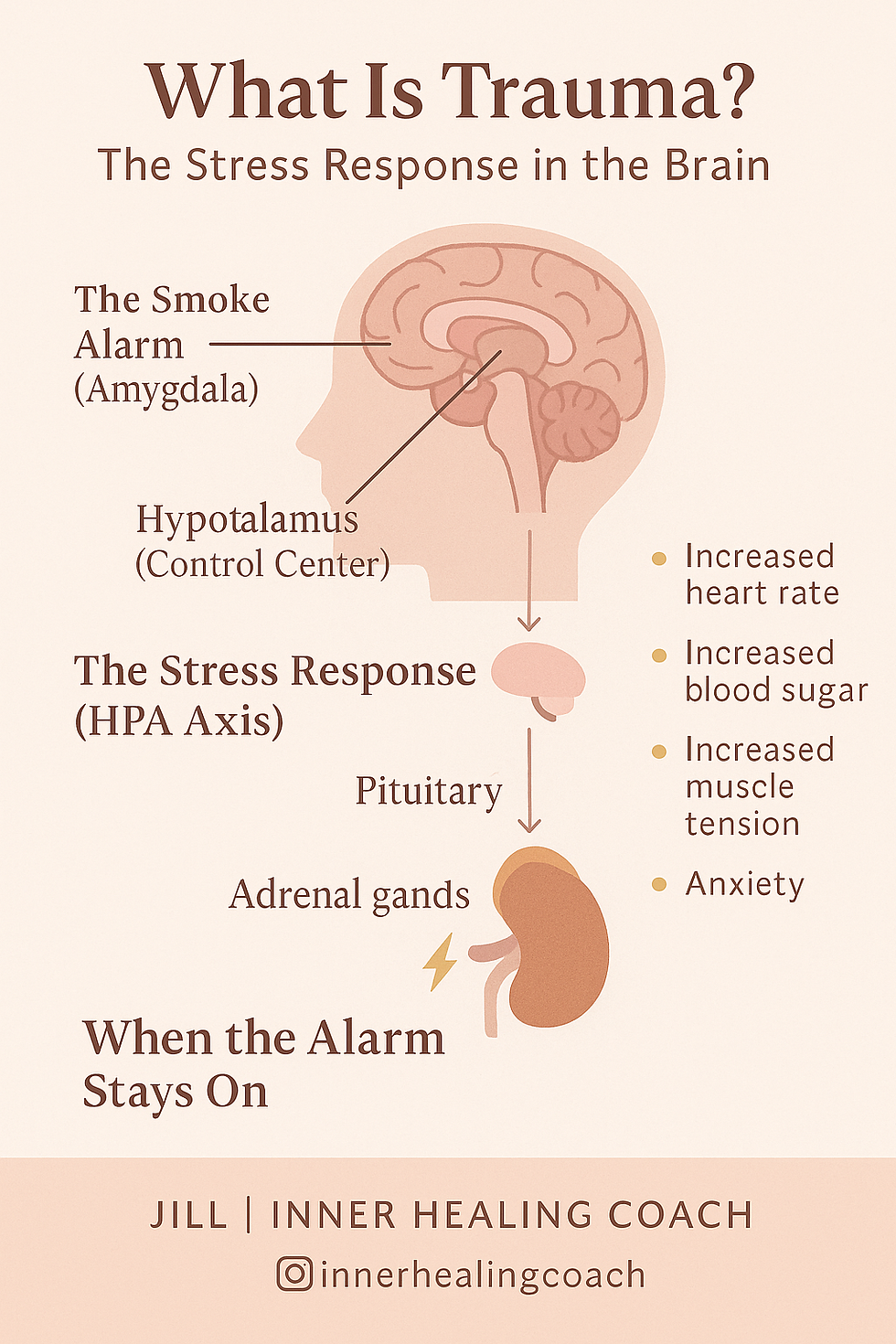What Is Trauma, Really?
- JILL | INNER HEALING COACH
.png/v1/fill/w_320,h_320/file.jpg)
- Oct 10
- 3 min read

When most people hear the word trauma, they think of the event itself—abuse, violence, an accident, or loss. But the truth is: trauma isn’t only what happened to you. Trauma is what happens inside your nervous system when your capacity to cope is overwhelmed.

The Brain’s Smoke Alarm
Inside your brain sits a small almond-shaped structure called the amygdala—think of it as your body’s smoke alarm.
Its job is to scan the environment for danger.
When it senses a threat, real or perceived, it sounds the alarm to the hypothalamus.
From there, a chain reaction begins that scientists call the HPA axis (hypothalamic–pituitary–adrenal system).
The hypothalamus signals the pituitary gland.
The pituitary sends a message to the adrenal glands.
The adrenals flood your body with cortisol and adrenaline ⚡—your fight, flight, or freeze hormones.
This cascade is designed to protect you. It sharpens your focus, quickens your heart, and prepares your muscles for action.
When the Alarm Stays On
This response is lifesaving in true danger. But when trauma overwhelms the body and there’s no safe way to discharge that energy, the system can get stuck.
The amygdala becomes hypersensitive, seeing danger everywhere.
The HPA axis stays over-activated, flooding the body with stress hormones.
The nervous system begins to live as if the trauma is still happening, even years later.
That’s why trauma isn’t just the event. It’s the long-lasting imprint on the brain, body, and spirit—the adaptations that keep us in survival mode.

My eBooks Your Brain Is Speaking & Your Body Is Listening and What Stress & Trauma Does in Your Body take you deeper into how little and big traumas affect your mind, body, and soul—and how faith and science together can help you heal.
A New Way to See Yourself
If you’ve ever wondered why, you can’t “just get over it,” this is why. Your body isn’t broken—it’s protecting you. Your brain isn’t failing—it’s doing its best to keep you alive.
Understanding trauma this way helps us trade shame for self-compassion.
You are not weak; you are wise. Your body simply needs support to find balance again.
Reflection
How might you use this “smoke alarm + stress response” picture to see your own responses with more compassion?
From Survival to Peace
When Inner Healing Isn’t Optional Anymore
You don’t have to keep fighting to hold it all together. You don’t have to keep trading your peace for protection. There is a gentler way—one where healing and holiness meet, and your nervous system can finally rest.

If this resonates with you, explore my eBooks and courses inside The Inner Healing Journey Method™, where I walk with you step by step to calm your nervous system, renew your mind, and heal your heart.
I created The Inner Healing Journey Method™ and a collection of faith-based, trauma-informed tools because I know what it feels like to lose yourself—and what it takes to rebuild.
✨ Inside, you’ll find resources to help you:
Reclaim control of your mind through renewing your thoughts in truth.
Reconnect with your body through practical healing tools.
Restore your identity in Christ and walk in freedom.
💜 Your healing matters. Your story matters. You matter.
👉 Begin today: www.innerhealingcoaching.com/shop-1
JILL | INNER HEALING COACH
Helping women reclaim their worth, restore their voice, and walk in healing.
References
Siegel, D. (1999). The Developing Mind.
LeDoux, J. (1996). The Emotional Brain.
van der Kolk, B. (2014). The Body Keeps the Score.




Comments